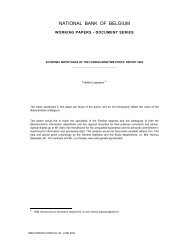A multi-factor model for the valuation and risk management of ...
A multi-factor model for the valuation and risk management of ...
A multi-factor model for the valuation and risk management of ...
You also want an ePaper? Increase the reach of your titles
YUMPU automatically turns print PDFs into web optimized ePapers that Google loves.
while only 3.4 years when <strong>the</strong> st<strong>and</strong>ard deviation <strong>of</strong> <strong>the</strong> margin is minimized. The 0.2 year result<br />
is atypical <strong>and</strong> due to <strong>the</strong> fact that long bond holding period returns are relatively volatile <strong>and</strong><br />
hence punished severely when <strong>the</strong>ir higher return is disregarded. When comparing <strong>the</strong>se replicating<br />
portfolio estimates with those that we estimated based on <strong>the</strong> no-arbitrage discounted cash ‡ow<br />
approach (panel B <strong>of</strong> Table 11 on page 17), we …nd that <strong>the</strong> criterion <strong>of</strong> minimizing <strong>the</strong> st<strong>and</strong>ard<br />
deviation <strong>and</strong> holding bonds until maturity results in estimates that are closest to <strong>the</strong> [-3.8,-3.2]<br />
range we found in our DCF framework (recall that <strong>the</strong> IRE <strong>of</strong> <strong>the</strong> level <strong>factor</strong> (with a minus sign)<br />
can be interpreted as a proxy <strong>for</strong> <strong>the</strong> modi…ed duration).<br />
Although <strong>the</strong> class <strong>of</strong> dynamic replicating portfolio <strong>model</strong>s is attractive, it has a number <strong>of</strong> important<br />
disadvantages. First, <strong>the</strong>se <strong>model</strong>s are inconsistent with <strong>the</strong> central no-arbitrage principle<br />
that underlies <strong>the</strong> bulk <strong>of</strong> asset pricing in …nance <strong>the</strong>ory <strong>and</strong> practice. Second, one is simply unable<br />
to estimate a DDA economic value when using replicating portfolio <strong>model</strong>s, in contrast to our<br />
no-arbitrage discounted cash ‡ow framework. Finally, in our experience <strong>the</strong> optimization exercises<br />
may result in quite di¤erent duration estimates when <strong>the</strong> objective criterion is changed to equally<br />
reasonable criterions or when <strong>the</strong> vector <strong>of</strong> available assets is exp<strong>and</strong>ed (yields are highly correlated<br />
throughout <strong>the</strong> maturity spectrum, <strong>and</strong> optimal portfolio weights may not be stable when di¤erent<br />
sets <strong>of</strong> assets are being considered). Moreover, it is unclear which setup <strong>and</strong> criterion should<br />
be used <strong>and</strong> how changes in duration are to be interpreted. The clear advantage <strong>of</strong> replicating<br />
portfolio <strong>model</strong>s is that it is more intuitive to explain <strong>and</strong> easier to implement compared to <strong>the</strong><br />
no-arbitrage DCF approach. Indeed, <strong>the</strong> absence <strong>of</strong> a <strong>valuation</strong> framework implies that <strong>the</strong>re is<br />
no need to switch to a <strong>risk</strong>-neutral pricing framework, which avoids <strong>the</strong> di¢ culties with market<br />
incompleteness.<br />
4 Policy implications<br />
DDA <strong>valuation</strong> has been a point <strong>of</strong> controversy with respect to <strong>the</strong> introduction <strong>of</strong> International Financial<br />
Reporting St<strong>and</strong>ards (IFRS), <strong>and</strong> more speci…cally IFRS 39 Financial Instruments: Recognition<br />
<strong>and</strong> Measurement. With respect to dem<strong>and</strong> deposits, <strong>the</strong> IASB (International Accounting<br />
St<strong>and</strong>ards Board), <strong>the</strong> international accounting rule-maker located in London, states very clearly<br />
that "<strong>the</strong> fair value <strong>of</strong> a …nancial liability with a dem<strong>and</strong> feature is not less than <strong>the</strong> amount<br />
payable on dem<strong>and</strong> ...". 19 The assumed continuous equality between fair (<strong>model</strong>-implied) <strong>and</strong> par<br />
value <strong>of</strong> DDAs also implies that DDA fair values are completely interest rate insensitive, i.e. <strong>the</strong>ir<br />
interest rate <strong>risk</strong> can only be hedged with <strong>the</strong> continuous roll-over <strong>of</strong> short term assets. Succinctly,<br />
deposit accounts with a dem<strong>and</strong> feature have a zero duration. Consistent with this stance, dem<strong>and</strong><br />
deposits are explicitly excluded by <strong>the</strong> IASB from hedge accounting provisions.<br />
The IASB stance is quite controversial, as it is inconsistent with banks’current <strong>risk</strong> <strong>management</strong><br />
practices, attaching relatively long durations to <strong>the</strong>ir DDAs grounded on <strong>the</strong> factual experience <strong>of</strong><br />
behavioral stability <strong>of</strong> deposits. Bankers also claim that <strong>the</strong> recording <strong>of</strong> DDAs at par e¤ectively<br />
injects arti…cial volatility in reported equity if <strong>the</strong>y are not allowed to recognize that outst<strong>and</strong>ing<br />
balances e¤ectively hedge <strong>the</strong> interest rate <strong>risk</strong> <strong>of</strong> medium-term assets. The issue has been discussed<br />
among accounting setters, bankers <strong>and</strong> bank supervisors in <strong>the</strong> runup to <strong>the</strong> adoption <strong>of</strong> IFRS by<br />
<strong>the</strong> European Commission. In <strong>the</strong> end, <strong>the</strong> EC decided to adopt IFRS, but only after "carving<br />
out" or deleting <strong>the</strong> IAS 39 hedge accounting rules. EU Member Countries are e¤ectively free<br />
to ei<strong>the</strong>r apply <strong>the</strong> carve out with respect to hedge accounting or to apply <strong>the</strong> hedge accounting<br />
provisions as originally devised by <strong>the</strong> IASB. 20<br />
19 Already in 1999, <strong>the</strong> Joint Working Group <strong>of</strong> St<strong>and</strong>ard Setters mentions "...<strong>the</strong> IASC/CICA Discussion Paper’s<br />
conclusion that <strong>the</strong> appropriate fair value measure <strong>of</strong> dem<strong>and</strong> deposits is likely to be close to <strong>the</strong>ir face value, <strong>and</strong><br />
that, unlike …xed rate loan assets, <strong>the</strong> fair value <strong>of</strong> dem<strong>and</strong> deposits is not likely to vary much with changes in<br />
interest rates" (JWG 1999).<br />
20 Importantly, <strong>the</strong> issue is also intimately linked to <strong>the</strong> discussion <strong>the</strong> IASB is having with insurers about <strong>the</strong><br />
21
















